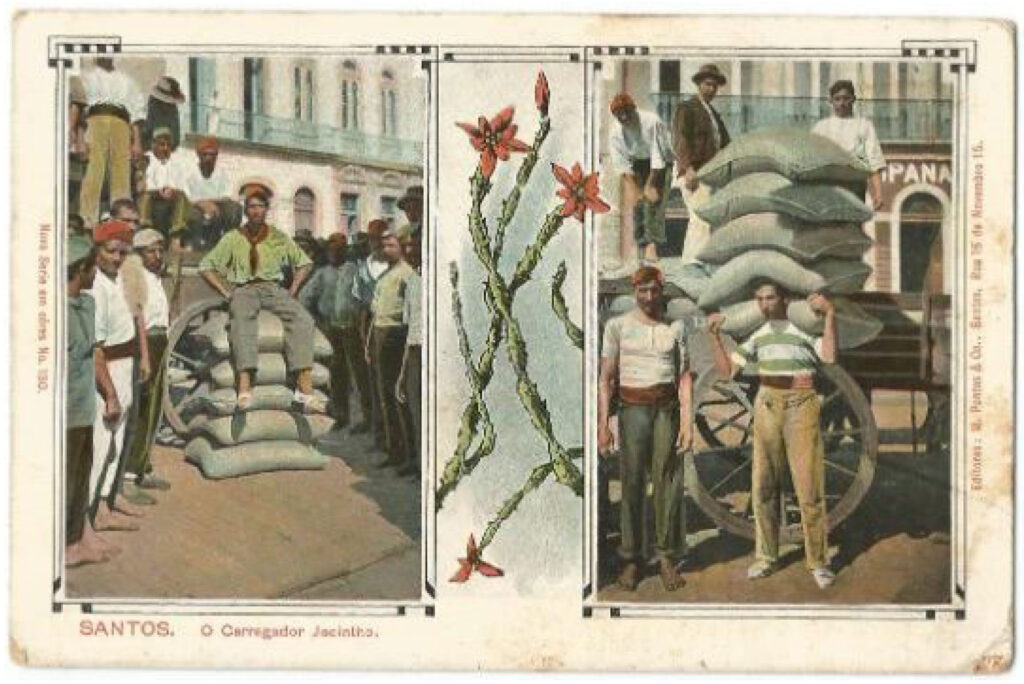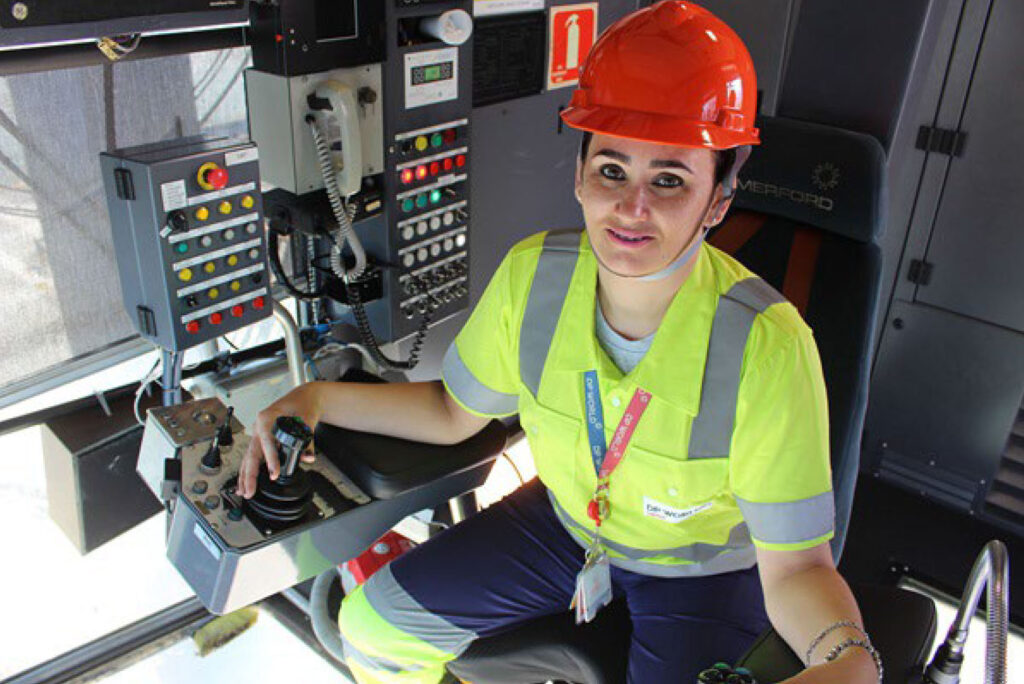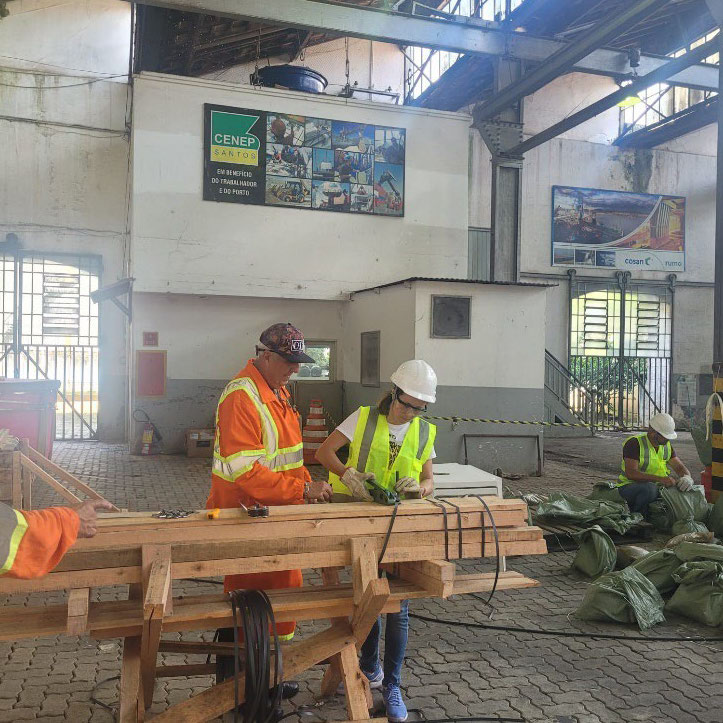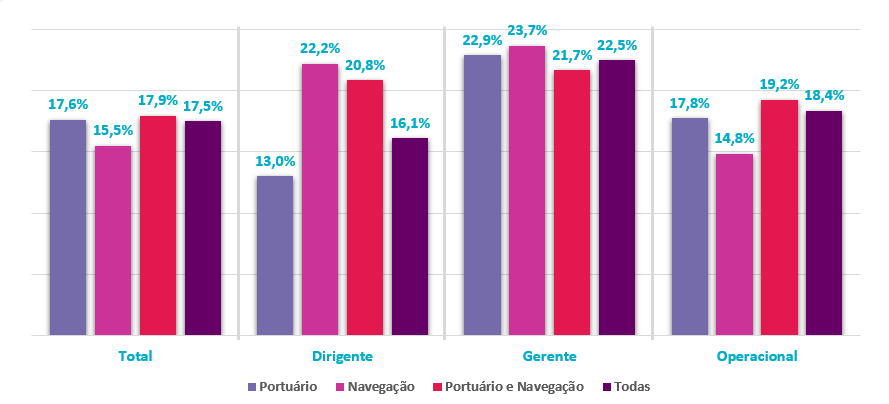╔
Mujeres en las ciudades portuarias: gobernanza y equidad de género en el sector portuario brasileño
El sector portuario brasileño ha estado experimentando cambios significativos en los últimos años. De la globalización y la entrada de nuevos actores dentro del escenario de infraestructura nacional, además del marco regulatorio de 2013 (BRASIL, 2013), surge que en el contexto pre y post pandemia COVID-19 con el impulso de los llamados buenos ESG ( prácticas de gobernanza social y ambiental), el sector portuario en Brasil comenzó a resaltar políticas de inclusión y equidad de género en los puertos y también en la industria naviera.
No sería nada nuevo, sobre todo teniendo en cuenta que Brasil tiene una mayor población de mujeres en su territorio (BRASIL, 2022). Sin embargo, hasta 2020 (Global Gender Gap Report), el país seguía ocupando el puesto 92. posición en un total de 153 países, teniendo una de las brechas de equidad de género más grandes de América Latina, ocupando la posición 22 entre 25 países de la región. Brasil logró la igualdad de género en los sectores de educación y salud, pero en el sector de bienes y servicios la brecha aún seguía siendo grande. La baja tasa de participación femenina en la fuerza laboral, combinada con salarios e ingresos más bajos, pesa sobre el desempeño del país en este subíndice (GUERISE, 2022, p. 23).
De hecho, no se puede ignorar que, cuando se trata de la industria de la navegación y el trabajo portuario, la participación femenina sigue siendo un desafío considerando la historia de la navegación y la propia relación puerto-ciudad. De un total de 1,2 millones de trabajadores marítimos en todo el mundo, aproximadamente el 1,5% son mujeres (BIMCO/ICS Seafarer Workforce, 2021).
Por otro lado, en el escenario post pandemia de COVID-19, el papel de los sectores de agronegocios y logística en la economía brasileña se ha vuelto más evidente. Y dentro de este nuevo escenario económico y social, algunas mujeres brasileñas comenzaron a participar de la economía informal o quedaron desempleadas, mientras otras mujeres comenzaron a invertir en preparación, ya sea para enfrentar un escenario de sucesión empresarial dentro de las empresas familiares, o para migrar su empleo. dentro de las empresas multinacionales y, en este sentido, el sector portuario está viviendo una profunda transformación.
Otro factor relevante para la existencia de esta transformación es la participación de actores nacionales y extranjeros en inversiones destinadas a infraestructura (instituciones económicas y financieras), además de que Brasil es signatario de compromisos internacionales orientados a políticas de equidad e inclusión, como como los ODS (Objetivos de Desarrollo Sostenible) de la ONU. El ODS 5, que trata de la equidad de género, deja clara la necesidad de lograr la equidad de género en las relaciones laborales.
El Puerto de Santos, el más grande del hemisferio sur, precisamente por tener mayor población femenina, se destacó entre los puertos que iniciaron el movimiento para incluir el género, con empresas como ADM (Archer Daniels Midland), que incrementó su número de mujeres en un 65% en los últimos 10 años (2024).
Ya sea en puestos de operaciones o en puestos de dirección y gestión administrativa, un movimiento que era tímido hace aproximadamente 30 años se ha convertido en una realidad para mujeres que, al principio, no eran bien vistas en los puertos brasileños. La historia de la relación puerto-ciudad nos lo muestra. Tradicionalmente, los puertos en Brasil fueron vistos como lugares insalubres, vectores de enfermedades y un atractivo para la prostitución femenina. Para una familia conservadora no era saludable que una mujer participara en el ámbito laboral portuario y mucho menos en la navegación.
Otro punto a destacar dentro de las denominadas buenas prácticas ESG es el papel de las empresas portuarias y navieras en relación con las comunidades más vulnerables socialmente en torno a las terminales. Los programas de formación y capacitación social son solicitados y han mostrado resultados beneficiosos en la generación de ingresos para las personas que se encontraban desempleadas.
La gobernanza, la tecnología, la innovación y la capacitación han demostrado ser instrumentos efectivos para la adopción de políticas de equidad de género en el sector portuario y de navegación en Brasil.
Históricamente, la tradicional fotografía de Jacinto, llamado “Sansão do Cais Santista”, uno de los innumerables estibadores brasileños del siglo XX, muestra cuán fundamental era el factor fuerza a la hora de trabajar en cualquier instalación portuaria de Brasil. Algunos trabajadores portuarios ni siquiera necesitaban saber leer y escribir (un vestigio de la época posterior a la esclavitud), siendo la fuerza bruta y la capacidad de llevar bolsas a la espalda el factor fundamental para trabajar en el puerto más grande del hemisferio sur.
The Brazilian port sector has been undergoing significant changes in recent years. From globalization and the entry of new actors within the national infrastructure scenario, in addition to the 2013 regulatory framework (BRAZIL, 2013), it emerges that in the pre and post COVID-19 pandemic context with the promotion of the so-called good ESG practices (social and environmental governance), the port sector in Brazil began to highlight policies of inclusion and gender equity in ports and also in the shipping industry.
It would not be anything new, especially considering that Brazil has a larger population of women in its territory (BRASIL, 2022). However, until 2020 (Global Gender Gap Report), the country continued to occupy the 92nd position in a total of 153 countries, having one of the largest gender equality gaps in Latin America, occupying the 22nd position among 25 countries of region. Brazil achieved gender equality in the education and health sectors, but in the goods and services sector the gap was still large. The low female participation rate in the labor force, combined with lower wages and income, weighs on the country’s performance in this subindex (GUERISE, 2022, p. 23).
Indeed, it cannot be ignored that, when it comes to the shipping industry and port work, female participation remains a challenge considering the history of shipping and the port-city relationship itself. Of a total of 1.2 million maritime workers worldwide, approximately 1.5% are women (BIMCO/ICS Seafarer Workforce, 2021).
It is important to mention that, in the post-COVID-19 pandemic scenario, the role of the agribusiness and logistics sectors in the Brazilian economy has become more evident. And within this new economic and social scenario, some Brazilian women began to participate in the informal economy or became unemployed, while other women began to invest in preparation, either to face a business succession scenario within family businesses, or to migrate your job within multinational companies and, in this sense, the port sector is undergoing a profound transformation.
Another relevant factor for the existence of this transformation is the participation of national and foreign actors in investments aimed at infrastructure (economic and financial institutions), in addition to the fact that Brazil is a signatory of international commitments aimed at equity and inclusion policies, such as the SDGs. (Sustainable Development Goals) of the UN. SDG 5, which deals with gender equality, makes clear the need to achieve gender equality in labor relations.
The port of Santos, the largest in the southern hemisphere, precisely because it has the largest female population, stood out among the ports that began the movement to include gender, with companies such as ADM (Archer Daniels Midland), which increased its number of women by a 65% in the last 10 years (2024).
Whether in operations positions or in management and administrative management positions, a movement that was timid approximately 30 years ago has become a reality for women who, at the beginning, were not well seen in Brazilian ports. The history of the port-city relationship shows us this. Traditionally, ports in Brazil were seen as unsanitary places, vectors of disease and an attraction for female prostitution. For a conservative family it was not healthy for a woman to participate in the port work environment, much less in navigation.
Another point to highlight within the so-called good ESG practices is the role of port and shipping companies in relation to the most socially vulnerable communities around the port terminals. Training and social training programs are requested and have shown beneficial results in generating income for people who were unemployed.
Governance, technology, innovation and training have proven to be effective instruments for the adoption of gender equity policies in the port and shipping sector in Brazil.
Historically, the traditional photograph of Jacinto, called “Sansão do Cais Santista”, one of the countless Brazilian dockers of the 20th century, shows how important the strength factor was for workers in any port facility in Brazil. Some dockworkers did not even need to know how to read and write (a holdover from the post-slavery era), with brute strength and the ability to carry bags on their backs the critical factor in working in the largest port in the southern hemisphere.

“O Carregador Jacintho”, postal editado por M. Pontes em Santos, c. 1910. (Disponible: https://museudocafesantos.medium.com/desconstruindo-jacinto-carregadores-de-caf%C3%A9-imigrantes-e-conflitos-%C3%A9tnicos-no-porto-de-santos-a6721b970509/; May 14, 2024).
“O Carregador Jacintho”, postcard edited by M. Pontes in Santos, c. 1910. (Available: https://museudocafesantos.medium.com/desconstruindo-jacinto-carregadores-de-caf%C3%A9-imigrantes-e-conflitos-%C3%A9tnicos-no-porto-de-santos-a6721b970509/; May 14, 2024).
Los tiempos han cambiado y sin duda, nuevas tecnologías y la innovación se han convertido en aliadas de las políticas de equidad de género en el sector portuario y de la navegación. Otros factores como la planificación orientada al cumplimiento de las normas laborales (como la ergonomía), la vestimenta y las instalaciones adecuadas para recibir mano de obra femenina fueron fundamentales.
Este es el caso de los recientes procesos de selección para recibir trabajadoras portuarias sueltas en el Puerto de Santos, un hito histórico considerando que, hacia 2023, solo quedaba una trabajando. A partir del proceso de selección realizado por OGMO (Órgano de Gestión de Mano de Obra), con el apoyo y participación de los sindicatos de trabajadores de la categoría, el proceso de selección incluyó a las dos primeras mujeres reparadoras de carga (carpintería naval) dentro de la plantilla única en la historia del puerto de Santos.
Según CENEP – Centro de Excelencia Portuaria de Santos, de los 3.400 trabajadores portuarios eventuales activos en el Puerto de Santos, 4 son mujeres.
CENEP (Centro de Excelencia Portuaria de Santos), Fundación Pública vinculada al Ayuntamiento y a la Autoridad Portuaria de Santos, también sumó su primer coordinador mujer en 2021. La entidad es responsable de la capacitación y calificación de trabajadores portuarios independientes y empresas privadas que operan dentro del Puerto de Santos, habiendo participado en los procesos de selección junto a OGMO y los Sindicatos de Trabajadores.
Fabiana do Nascimento Almeida es la primera y única operadora de porteadores del Puerto de Santos. Su inserción y formación se realizó por iniciativa de la empresa en la que opera, DP World, que, en su marco, también cuenta con mujeres ocupando puestos directivos.
Times have changed and without a doubt, new technologies and innovation have become allies of gender equality policies in the port and navigation sector. Other factors such as planning aimed at compliance with labor standards (such as ergonomics), clothing and adequate facilities to receive female labor were essential.
This is the case of the recent selection processes to receive loose female port workers in the Port of Santos, a historic milestone considering that, by 2023, only one remained working. Based on the selection process carried out by OGMO (Manpower Management Body), with the support and participation of the workers’ unions of the category, the selection process included the first two women cargo repairers (naval carpentry) within the unique template in the history of the port of Santos.
According to CENEP – Santos Port Center of Excellence, of the 3.400 temporary port workers active in the Port of Santos, 4 are women.
CENEP (Centro de Excelencia Portuaria de Santos), a public foundation related to City Hall and the Santos Port Authority also added its first female coordinator in 2021. The entity is responsible for training and qualification of independent port workers and private companies that operate within the Port of Santos, having participated in the selection processes alongside OGMO and the Workers Unions.
Other example is Fabiana do Nascimento Almeida, the first and only woman porter operator in the Port of Santos. Her insertion and training was carried out at the initiative of the company in which she operates, DP World, which, within its framework, also has women occupying management positions.
Fabiana do Nascimento Almeida es la primera operadora de portacontainer del puerto de Santos. (Fuente: DP World. Disponible: https://www.dpworld.com/pt-br/brazil/news/latest-news/dp-world-santos-reaches-the-womens-day-with-record-number-of-women-working-at-the-port/).
Fabiana do Nascimento Almeida is the first container operator in the port of Santos. (Source: DP World. Available: https://www.dpworld.com/pt-br/brazil/news/latest-news/dp-world-santos-reaches-the-womens-day-with-record-number-of-women-working-at-the-port/).

Primera mujer reparadora de cargas de Puerto de Santos, Nathalia Conde Simões. (Fuente: CENEP archivo personal).
First woman cargo repairer in Puerto de Santos, Nathalia Conde Simões. (Source: CENEP personal archive).

Además de los puestos operativos, la participación de las mujeres en puestos directivos en el sector portuario y de la navegación también está experimentando cambios, con desafíos por superar. Un ejemplo de una iniciativa de gobernanza exitosa entre entidades del tercer sector y autoridades públicas es el acuerdo de cooperación entre WISTA (Women’s International Shipping and Trading Association), una organización internacional que opera también en Brasil, y ANTAQ (Agência Nacional de Transportes Aquaviários) [1].
La investigación es la primera de las acciones del Protocolo de Intención, firmado en marzo de 2022, entre la Agencia y la Asociación de Mujeres de Transporte y Comercio Internacional (WISTA-Brasil) que busca la igualdad de género en el sector. Toda la encuesta es de dominio público.
Los datos recopilados mostraron, en 2023, que las mujeres todavía ocupaban sólo el 17,5% del total de las vacantes en el sector navegable brasileño, lo que sigue la tendencia mundial de ocupaciones femeninas de puestos en el sector.
Por otro lado, teniendo en cuenta que en estadísticas anteriores los valores no llegaban al 14%, efectivamente hubo un aumento de la fuerza laboral femenina en el sector portuario brasileño. Las empresas que operan tanto en el sector portuario como en el de la navegación lideran el ranking de participación femenina, con el 17,9% de los puestos ocupados. En el sector marítimo, por su parte, más del 23% de los puestos directivos están ocupados por mujeres.
In addition to operational positions, women’s participation in management positions in the port and shipping sector is also undergoing changes, with challenges to overcome. An example of a successful governance initiative between third sector entities and public authorities is the cooperation agreement between WISTA, an international organization operating in Brazil, and ANTAQ, the regulatory agency of the Brazilian executive branch [1].
The investigation is the first of the actions of the Protocol of Intent, signed in March 2022, between the Agency and the Women’s Association of Transport and International Trade (WISTA-Brazil) that seeks gender equality in the sector. The entire survey is in the public domain.
The data collected showed, in 2023, that women still occupied only 17.5% of the total vacancies in the Brazilian navigable sector, which follows the global trend of female occupation of positions in the sector.
On the other hand, taking into account that in previous statistics the values did not reach 14%, there was indeed an increase in the female workforce in the Brazilian port sector. Companies that operate in both the port and navigation sectors lead the ranking of female participation, with 17.9% of the positions occupied. In the maritime sector, for its part, more than 23% of management positions are occupied by women.
Participación de las mujeres en el sector marítimo y portuario brasileño. Datos generales. (Fuente: ANTAQ, 2023. Available: https://www.gov.br/antaq/pt-br/noticias/2023/antaq-divulga-levantamento-sobre-equidade-de-genero-no-setor-aquaviario/).
Participation of women in the Brazilian maritime and port sector. General data. (Source: ANTAQ, 2023. Available: https://www.gov.br/antaq/pt-br/noticias/2023/antaq-divulga-levantamento-sobre-equidade-de-genero-no-setor-aquaviario/).

La recogida y publicación de resultados fomenta la adopción de prácticas de buen gobierno, ya que tiene como finalidad profundizar en el conocimiento del sector hidrovía en relación con sus trabajadores, además de servir como punto de partida por parte de las empresas del sector para mejorar las políticas dirigidas a Equidad de género. En total, 302 empresas del sector respondieron a los cuestionarios (ANTAQ, 2023).
Además de las estadísticas proporcionadas por el Protocolo de Intenciones firmado entre WISTA y el gobierno brasileño, asociaciones y movimientos por la igualdad de género que realizan mapeos de las mujeres en el sector portuario brasileño, como el titulado “Mujeres y Puertos”, iniciado en Brasil en 2022, comenzó a resaltar la importancia de la inserción de las mujeres en el sector portuario brasileño, uniendo a trabajadores de los principales puertos del país, tanto en puestos directivos como operativos.
Dentro del Poder Ejecutivo brasileño, la participación femenina en puestos directivos comenzó hace algunos años. Se destacan Mariana Pescatori (primera Secretaria Ejecutiva del Ministerio de Puertos y Aeropuertos) y Flávia Takafashi (primera y única Directora de ANTAQ, responsable de regular la actividad en el país).
En las autoridades portuarias, pocas tenían mujeres como presidentas. Se destaca Gilmara Timóteo, presidenta de 2015 a 2023 de la Companhia Docas do Estado da Paraíba, empresa estatal responsable de la administración del Puerto de Cabedelo.
Las nuevas tecnologías, utilizadas adecuadamente y con la debida formación, permitieron que las mujeres tuvieran más oportunidades en un sector predominantemente masculino. Es claro que la mecanización y la automatización no solo los han colocado como trabajadores de primera línea, sino que también los han llevado a ocupar puestos en las áreas de TI, en las áreas de administración, contabilidad, logística, como personal jurídico de empresas y terminales, y puestos de alta dirección en empresas privadas o agencias reguladoras estatales, todos ellos anteriormente dominados únicamente por hombres (GONTIJO, 2021)
Se puede concluir también que los instrumentos de gobernanza se vuelven fundamentales para la adopción de prácticas orientadas a la equidad de género en el sector portuario, principalmente en Brasil. Desde la adopción de compromisos internacionales por parte de Brasil hasta la participación de grupos económicos en nuevas inversiones para la construcción, implementación y gestión de nuevas terminales portuarias, todos estos ejemplos ayudaron a aumentar el número de mujeres en el sector, cuando los compromisos se asumen con calidad y compromiso. Incluso considerando que los cambios ocurren lentamente, la transformación e implementación de políticas de equidad de género en el sector portuario brasileño está ocurriendo.
The collection and publication of results encourages the adoption of good governance practices, since its purpose is to deepen the knowledge of the waterway sector in relation to its workers, in addition to serving as a starting point for companies in the sector to improve the policies aimed at gender equality. In total, 302 companies in the sector responded to the questionnaires (ANTAQ, 2023).
In addition to the statistics provided by the Protocol of Intentions signed between WISTA and the Brazilian government, associations and movements for gender equality that carry out mappings of women in the Brazilian port sector, such as the one titled “Women and Ports”, initiated in Brazil In 2022, it began to highlight the importance of the insertion of women in the Brazilian port sector, uniting workers from the country’s main ports, both in management and operational positions.
Within the Brazilian Executive Branch, female participation in management positions began a few years ago. Mariana Pescatori (first Executive Secretary of the Ministry of Ports and Airports) and Flávia Takafashi (first and only Director of ANTAQ – National Waterway Transport Agency, responsible for regulating activity in the country) stand out.
In the port authorities, few had women as presidents. Gilmara Timóteo stands out, president from 2015 to 2023 of the Companhia Docas do Estado da Paraíba, a state company responsible for the administration of the Port of Cabedelo.
New technologies, used properly and with proper training, allowed women to have more opportunities in a predominantly male sector. It is clear that mechanization and automation have not only placed them as front-line workers, but have also led them to occupy positions in the IT areas, in the areas of administration, accounting, logistics, as legal personnel of companies and terminals, and senior management positions in private companies or state regulatory agencies, all previously dominated solely by men (GONTIJO, 2021).
It can also be concluded that governance instruments become fundamental for the adoption of practices aimed at gender equality in the port sector, mainly in Brazil. From the adoption of international commitments by Brazil to the participation of economic groups in new investments for the construction, implementation and management of new port terminals, all these examples helped increase the number of women in the sector, when commitments are assumed with quality and commitment. Even considering that changes occur slowly, the transformation and implementation of gender equity policies in the Brazilian port sector is occurring.
IMAGEN INICIAL | En diez años (2014-2024), el número de mujeres que trabajan en el puerto de Santos aumentó un 65%. (Fuente: Thiago de Jesús/Globo Rural).
HEAD IMAGE | In ten years (2014-2024), the number of women working at the port of Santos increased by 65%. (Source: Thiago de Jesus / Globo Rural).
╝
NOTA
NOTE
[1] ANTAQ es la agencia brasileña responsable de regular, supervisar y monitorear las actividades de prestación de servicios de transporte fluvial y operación de infraestructura portuaria y fluvial.
[1] ANTAQ is the Brazilian agency responsible for regulating, supervising and monitoring the activities of providing river transportation services and operating maritime ports and river infrastructure.
REFERENCIAS
REFERENCES
BIMCO. Do we have the courage to inspire? Disponible: https://www.bimco.org/insights-and-information/general-information/20240514-stinne-interview (May 14, 2024).
BRASIL. IBGE. Censo demográfico 2022. Disponible: https://educa.ibge.gov.br/jovens/conheca-o-brasil/populacao/18320-quantidade-de-homens-e-mulheres.html#:~:text=Os%20resultados%20do%20Censo%20Demogr%C3%A1fico,da%20popula%C3%A7%C3%A3o%20residente%20no%20pa%C3%ADs. (May 14, 2024).
BRASIL. ANTAQ – Agência Nacional de Transportes Aquaviários. ANTAQ divulga levantamento sobre equidade de gênero no setor aquaviário, 2023. Disponible: https://www.gov.br/antaq/pt-br/noticias/2023/antaq-divulga-levantamento-sobre-equidade-de-genero-no-setor-aquaviario (May 14, 2024).
GONTIJO, Maria Cristina. A Tecnologia como aliada das mulheres no Mercado de trabalho portuário. Disponible: https://protagonismocidadao.com.br/gargalos-de-nosso-sistema-como-estamos-enfrentando-maria-cristina-gontijo-artigo/ (May 14, 2024).
GUERISE, Luciana. Mulheres para além do 8 de março. In. WISTA BRAZIL. Porto, Mar e Comércio Internacional Por Elas. Ediciones Milfontes. Vitória, Brasil, 2022.